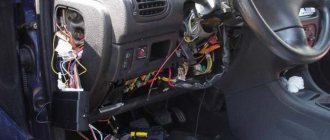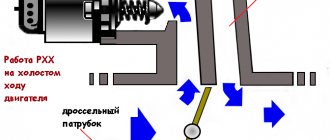Gas equipment for cars
As you know, there are two types of gas equipment that are installed in cars to save on fuel.
It would seem that gas and gas, what is the difference here, but it is quite significant, let’s figure out what’s going on here: Methane is natural gas that is extracted from underground, the same gas goes through yellow pipes between houses and comes to you kitchen. (however, you won’t be able to refuel a car from a kitchen stove for free - there won’t be enough pressure in the pipe to fill the cylinder at least noticeably).
Propane-Butane is liquefied petroleum gas. The very first and purest fraction from oil distillation. Petroleum product.
It would seem that methane is more natural, it is natural gas, so everything in it should be simpler, easier and cheaper... but this is not entirely true. Yes, the gas itself is cheaper than that obtained from oil refining at the plant. but it has a completely different formula, and it does not go into a liquid stage when the pressure increases to the level that can be created in automobile cylinders. It compresses much worse and more difficult - hence the first drawback: it requires high-pressure cylinders, which themselves are much heavier and more expensive than propane.
So, the disadvantages of methane:
- High-pressure cylinders are needed: they take up a lot of space in the trunk, weigh a lot, which makes the equipment expensive: twice as expensive as propane. If LPG propane for a regular car with 4 cylinders will cost you about 25,000 rubles when installed in Moscow in 2020, then LPG methane will cost you 50,000 rubles - twice as much.
- High pressure - if the consequences of a rupture of a propane tank are generally harmless (you can find videos on YouTube) and everything happens much safer than a gasoline explosion in a gas tank, then methane is already a very high pressure. Many people are afraid to carry such a charge of energy with them.
- Our service is periodically asked to convert a car from methane to propane. But on the contrary, no one will forgive conversion - propane is clearly more convenient.
- There are very few methane gas stations - surprising, but perhaps this is the biggest drawback. There are no methane gas stations on the highways at all, and this is not surprising - no pipe, no gas station.
Indeed, it is very strange - in Russia, a country with a raw materials economy, where Gazprom is a “national treasure” - you will hardly find a methane gas station. In Moscow they are located mainly on the Moscow Ring Road, and on its outer radius. For those who travel on business within the city, this will not be very convenient.
So who installs gas equipment on methane and why? HBO on Methane is quite popular among Gazelle owners:
- Between the frame and the body there is just a place where you can stuff several high-pressure cylinders.
- Gazelle is a car with fairly high fuel consumption. Methane may be expensive at the stage of installing gas equipment, but this is only an initial investment - and then there is pure savings, and yes, it is better than with propane.
- The main argument of gazelleists in favor of methane is that it becomes cheaper for them to drive a gazelle than a passenger Zhiguli. Well, that’s approximately how it is.
Advantages of installing propane-butane gas equipment:
- This is something that can be put in passenger cars without losing much of the cargo capacity and without losing any trunk space at all if you put a toroidal tank instead of a spare tire. Do you feel sorry for the spare tire? Do you remember how long ago you used it, how many times did you take it out over the last 3 years? Never? Well, if you’re going somewhere long, you can just put it in the trunk. If you are somewhere in the city and suddenly something happens to you, there is a tire shop on every corner, remove the wheel and take it straight for repairs... or you can buy a small spare tire, for which it will be much easier to find a place in the trunk.
- It is much safer than methane. The pressure in a propane cylinder is 16 atmospheres. For comparison, a bicycle pump can pump up 7-8.
- Propane gas equipment is cheap - installation on ordinary 4 cylinders of an injection car, only 26,000 rubles. For a carburetor it’s even cheaper, about 18,000 with a large cylinder. This is a high-quality gas equipment from Europe for which the installer will give a 3-year guarantee without mileage limitation.
- Installing LPG on propane does not affect engine life. Taxi cars travel 500,000 km with Lovato LPG.
- There are many propane gas stations; in Moscow they are in every district. Study the map, find a few that are convenient for you.
Well, here's the deal, friends. The disadvantages of gas gas methane forced us to temporarily refuse to work with this equipment, the main reason: there are few refills. We have had clients switch from methane to propane for this reason. We advise installing gas equipment on methane only to those who have already consciously found for themselves some obvious advantages in this type of fuel.
LPG with methane: is it advisable to install it on a passenger car and its cost?
Gasoline is becoming increasingly expensive for Russian drivers. Therefore, motorists are switching en masse to a cheap and environmentally friendly type of fuel – gas. Currently, the most common gas engine fuel is propane. The question arises: why, if methane is cheaper? Today, there are many times more propane gas stations than methane gas stations. But over time, the number of the latter is gradually increasing, so installing gas equipment on methane is an issue that does not lose relevance.
Which is better - propane or methane?
Propane has more advantages, but they are offset by the cheapness of methane.
The main advantages of propane-butane mixture:
- equipment and its installation require lower costs;
- the weight of the equipment is insignificant, the dimensions are also insignificant;
- the engine loses only 5–10% of power.
- a liter of propane is 3-5 rubles more expensive, with a full tank the overpayment is significant;
- an explosion of a cylinder with such gas is more likely.
Methane-powered equipment on a car of any generation ensures environmental friendliness. After all, this gas is pumped into cylinders in the same form in which it was extracted from the depths. Without processing and impurities. In case of leakage, it quickly mixes with air.
The equipment and its installation are many times more expensive than for propane. And the large weight of the cylinder adds inconvenience. It weighs a lot due to the thick walls, because the pressure inside the container can be more than 200 atm.
A passenger car running on methane loses up to 15% of its power, which is slightly more than that of propane.
By 2020, the government plans to significantly expand the network of methane gas stations. In addition, methane is produced in Russia, price stability is ensured. The prospect of saving on fuel itself is excellent.
Before choosing the type of gas motor fuel for your car, it will be useful to read the article “Which is better – propane or methane,” which describes in detail the advantages and disadvantages of using these gases.
Is it possible to install HBO yourself?
The law prohibits the installation of gas equipment by persons who do not have a special certificate to perform such work. In addition, you must first undergo an examination that will show whether it is possible to make such changes to the design of your car.
In the case of methane, we are dealing with a substance compressed under enormous pressure. This is another reason why you should not trust the installation to inexperienced workers.
In addition, installation of gas equipment using methane requires modification of the car.
Only an experienced mechanic can make the optimal connection to the methane power supply system. Also, during installation, there is a need to strengthen the frame structure, because the cylinder is heavy.
Installing methane gas equipment at a special station is not cheap. This is despite the fact that the purchase of the equipment itself already incurs large capital costs. And the fine for driving a vehicle with an unregistered gas equipment is only 500 rubles. Therefore, many drivers are willing to pay single fines, saving on installation costs. At the same time, the question arises whether it is, in principle, possible to convert a car to methane on its own.
It is possible to perform installation in a garage environment. But if you are not an expert and try to do it according to the instructions, you risk your own safety.
How does the installation work?
The installation of methane in a passenger car begins with disconnecting the battery. Next, the intake manifold is dismantled and gas nozzles must be installed on it. Before installation, mark the points for the holes and drill them at the required angle. Threads are cut into the holes, glue is applied to the nozzles and screwed in. Rubber hoses will be placed on the other end of the nozzle and tightened with clamps.
Then we put the collector in place. We install the same nozzle in the housing with the throttle valve as in the manifold. Next, calibrated nozzles are selected to connect the ramp injectors with gas hoses. The resulting connection should be firmly fixed to the motor using a special bracket.
When installing methane gas equipment, the car must have a gearbox. It regulates the pressure in the system and the composition of the combustible mixture. We connect it with tubes to the cooling system and secure it to the body. We attach a pressure gauge to the gearbox to measure internal pressure.
In order for clean gas to enter the cylinders, it is necessary to install a methane filter. Its location is between the gearbox and the injectors. Connect the plug on the filter to the wiring.
A line is laid under the car from the cylinder to the valve with a tap through which refueling will take place. The choice of installation location for the electronic control station is carried out based on two conditions: wiring must be easily supplied there, and also this place must be isolated from accidental splashes of technical fluids.
Next, we connect the electrical wiring and bring a wire into the cabin to install the switch. It is needed to switch from gasoline to methane directly from the cabin. We secure the cylinder in the trunk. This completes the conversion of the car to methane.
This is what the HBO installation looks like in general terms.
Price and installation time
The price for turnkey installation of methane equipment varies depending on the engine size and cylinder. The installation cost is also affected by the generation of gas equipment. The second generation equipment is installed on carburetor cars, the fourth – on injection cars.
On average in Russia the price will be 40,000-50,000 rubles. The period for converting a car to natural methane gas usually does not exceed 2-3 days.
For an additional fee, for drivers switching to methane, many stations include options such as equipping the cylinder valve with an electromagnetic valve, equipping the system with a variator ignition, and installing a valve protection system. At different stations, the cost of each of these services will be 2,500–4,500 rubles.
HBO methane on Niva: Video
Specialist in lending to individuals and small and medium-sized businesses. Experience in the banking sector – more than 15 years.
LPG with propane or methane: what to choose? (We answer)
When installing gas equipment on a car, the question always arises of which gas to choose. The type of LPG installed and the performance characteristics of the vehicle depend on this. Today, two types of gas are used: propane and methane.
Features of propane
Propane gas is the main component of liquefied gas (propane-butane mixture). It is a by-product of petroleum refining. This gas is stored under relatively low pressure, which is 16 atmospheres. Due to this, thin-walled cylinders (wall thickness from 3 mm) are used for its storage. This provides a significant advantage in the form of low weight of installed equipment. The weight of a filled gas cylinder with a volume of 50 liters is only 44 kilograms.
Another important advantage of propane is the developed network of gas filling stations. Thanks to this, vehicle owners practically do not face the problem of refueling even during long trips. The downside of propane is its higher gas consumption.
Features of methane
Methane is a naturally occurring gas that is stored under a pressure of 200 atmospheres in a gaseous state. Given the significant gas pressure, the wall thickness of methane cylinders is higher. The weight of one 50 liter cylinder is 63 kilograms. At the same time, given the gaseous state of methane, it is necessary to use a larger number of cylinders. On average, one propane cylinder is identical in gas cubic capacity to three methane cylinders.
Modern methane cylinders can be made of composite materials. This allows you to significantly reduce their weight. However, the cost of such cylinders is much higher. Another disadvantage is the poorly developed network of gas filling stations, which are used for refueling with methane. In addition, methane gas treatment is more expensive. The advantages of this gas include its lower consumption compared to propane.
conclusions
In general, in terms of fuel characteristics, both types of gas can be used in cars without any special restrictions. However, when choosing, you need to take into account the characteristics of each type of gas and the characteristics of the car.
Thus, methane benefits due to lower consumption and lower cost of the gas itself. This makes its use cost-effective (even taking into account expensive gas equipment) for cars with a significant engine capacity, as well as on cars with high average annual mileage. It is methane equipment that is most often used in commercial vehicles of various types. Propane is a more preferable option for ordinary passenger cars that are used for private purposes.
What you need to know about gas treatment with methane in 2020
Before installing gas equipment (LPG), most motorists have questions about what kind of installation to install, what fuel, what generation is more suitable and what will be more profitable. We will try to figure out how feasible it is to install gas equipment on methane, consider all types of installations compatible with this gas and highlight their pros and cons.
Idea of a gas installation on a car
Considering the fact that not only liquid fuel is suitable for an internal combustion engine, installations were invented that use gas as fuel. They were invented primarily to save money at the gas station, since gas is cheaper, although there is an opinion that liquid combustible mixtures are still a little “healthier” for the engine. Nevertheless, HBO has gained great popularity and, according to many experts, does not harm the engine at all, but, on the contrary, increases its service life.
There are now six generations of such equipment, and four of them can operate on different gases. Despite all the diversity, they have the same general operating principle. From the cylinder, gas under high pressure flows through the main line into the filter valve, where it is cleaned of impurities. Then it goes to the reducer, the pressure returns to the operating norm, after which the fuel enters the mixer through the control valve, and then into the engine. But this is a general diagram that does not take into account many important components, but only shows the principle of operation of the installation.
Fuel options for LPG
There are only two types of fuel that can be used in gas installations - methane and propane. Moreover, the latter is most often found with an admixture of butane in different proportions. The installed equipment has design amendments depending on the fuel being filled, so it is impossible to fill the same gas equipment with different gases. Since the characteristics of gases are different, you will need to choose the most suitable option for your purposes.
Find out what is better to choose for your car - methane or propane.
Generations of gas equipment running on methane
This gas has been used since the very first generations of gas equipment. Moreover, it is even better suited for earlier versions of installations. This is explained by the fact that methane-powered equipment is mainly used on trucks, many of which have carburetor or mono-injection engines. HBO of the 1st or 2nd generation is suitable for them, respectively.
Starting from the third generation, the gas equipment of a methane-powered car received a significant increase in electronics and became slightly automated. On systems of this type, gas injection is carried out under the control of an electronic unit. This allows you to more accurately adjust the fuel supply through the dispenser-distributor. In addition, a significant difference was the injector emulator, which replaced the gas valve. This solution will stop the supply of gasoline, creating only the appearance of the gasoline injectors working, so that the on-board computer does not fail.
The fourth generation of LPG for methane-powered cars has become even more advanced. It featured special gas injectors and a more advanced electronic control unit. In systems of this type, gas is supplied in a slightly different way: it enters directly into the manifold through electromagnetic injectors. But the state of aggregation of the gas does not change, only the pressure. Therefore, such installations can still run on methane.
Starting from the fifth generation of equipment, the principle of gas supply changes radically. Now the fuel from the cylinder to the manifold should not flow in a gaseous state, as before, but in a liquid state. This contradicts the physics of methane, which cannot be liquid at any pressure above -80 degrees. Accordingly, installations of version 5 and higher can only operate on propane.
Features of methane plants
Like any other type of fuel, methane has its own distinctive features. It is a natural gas that requires little filtration. When burned, it does not emit almost any harmful substances and is considered environmentally friendly. Installations using this gas are almost identical to propane ones in almost all respects, with the exception of some details:
- Seamless high pressure pipes.
- Own standard of filling device.
- Gas reducer.
- High pressure gauges for checking the amount of gas.
- High strength cylinders.
There are also features regarding how a methane-powered car will behave on the road. Usually there is a decrease in engine power and an increase in weight, which, accordingly, will affect acceleration, maneuverability and braking. The usable space in the trunk will also decrease, unless we are talking about a truck or minivan, of course. This will already happen due to the characteristics of the cylinders.
Take a sociological survey!
Features of cylinders
Due to the high pressure at which methane must be stored, cylinders for it must be especially durable. This makes them very heavy and takes up a lot of space. There are three types of cylinders for this gas. They differ in weight, amount of space taken up and price. Here are examples from the most expensive to the budget option:
- Composite (strong and lightweight materials are used).
- Metal-plastic (there is metal around the edges, but in the center there is a winding of composite materials, for which a cone-shaped hole is ground off).
- Metal (all-metal cylinder with thick walls).
The first two types have a service life of no more than 15 years, and the last - no more than 20. Composite and semi-composite cylinders can be of different sizes and shapes, depending on the volume. While metal ones, to increase the fuel capacity, are most often installed in bundles in a metal frame, which further burdens the already difficult structure. Although there may be exceptions that will cost more.
It is precisely because of its weight and dimensions that a methane-powered passenger car is not as common as a truck. After all, in order to reduce the weight and volume of installed equipment, you will need to spend a considerable amount, which promises long-term payback, despite the cheapness of gas. Otherwise, you're giving up the trunk.
How to install gas equipment on methane
Before installation, you need to do some preparatory work. First of all, disconnect the battery. Then the intake manifold is dismantled. After which you can install methane gas equipment on the car. For this:
- Gas nozzles are installed on the intake manifold.
- The nozzles are connected to the gas hoses and tightened securely at the mounting point.
- The collector is installed back in its place.
- A nozzle is installed to the throttle valve, directly into the body (similar to how it was with the manifold).
- The gearbox is installed and connected to the filter.
- A pressure gauge is installed on the gearbox to measure pressure.
- If the LPG has an electrical control unit, it must be installed in the most dry and protected place possible.
This is where the installation difficulties end, since you won’t need to modify anything else in the car’s details. But in order for the installation of gas equipment on methane to be completed, you will also need to weld a metal frame for the cylinders and place it in a suitable place. It could be:
- cargo compartment;
- trunk;
- the space between the cab and the body, or even between the wheel axles under the vehicle.
Installation cost
It is impossible to clearly determine installation prices. It is necessary to take into account the different costs of parts, generation of gas equipment, engine power, size and type of cylinders, cost of service at a service station and many other parameters. But even with minimal requests, converting a car to methane will cost more than to propane. This is due not only to the cost of the equipment, but also to the large number of required permits.
But the payback for this equipment is still higher than for propane equipment. Especially if it is installed on commercial or public vehicles that drive more than they sit idle.
It will cost a little more to install methane in a passenger car, because it has little space in the trunk, low ground clearance and carrying capacity. Therefore, you need to choose cylinders made of lightweight composite materials, which are more expensive and wear out faster.
Advantages of gas treatment with methane
There are quite a lot of arguments to switch to methane plants. Among the main ones:
- Reduced engine noise.
- High fuel economy.
- Environmentally friendly.
- Natural gas requires almost no filtration.
Flaws
Despite the fact that there are more disadvantages and they are significant, methane for cars is popular, albeit in a narrow circle. Its main disadvantages are:
- Bulkyness and weight of cylinders.
- Small range given the size of the cylinders.
- Cost of equipment due to the need for components operating under high pressure.
- Noticeable loss of dynamics and power.
- Reduced valve life.
Is it worth switching
Like any type of specialized equipment, gas equipment running on methane has its own consumer circle. These are mainly owners of transport companies, fleets or cars that travel frequently and for a long time, but within the same city (for example, taxis). In such cases, installation is a necessity, as it will help significantly save money. But this does not mean that you do not have the right to install methane equipment on your car. It will just take longer to pay for itself, and it will be more difficult to find a gas station.
Switching to LPG – propane or methane. Usage experience: video
Practicing lawyer with 10 years of experience. Specializations: criminal law, insurance law, administrative offenses.
Installation of gas treatment methane
Check out the latest discounts and special offers
We recommend installation on most cars
Is HBO safe, some work, promotional videos
Installation of gas equipment on methane
Methane is a natural gas whose density is incomparable to that of gasoline. Therefore, it is filled into high-pressure cylinders, compressing it to a couple of hundred atmospheres. Actually, these same cylinders are installed in cars.
Advantages of installing gas equipment on methane in a car
1) The octane number of methane is higher than that of 98-octane gasoline (110), and it costs three times less than it, and almost 2 times less than propane, which is the first plus in favor of this gas. The price of installing gas equipment on methane starts from 44,000 rubles. It all depends on the make of the car, the number of cylinders and the choice of the manufacturer of the installed equipment.
2) The second undoubted advantage of this fuel is its environmental friendliness. As a result of the combustion of this gas, water and carbon dioxide are obtained, which has a positive effect on the environment.
3) Cost-effectiveness, of course, most people install methane gas equipment on their cars for the sake of economy. And savings when using methane reach the following indicators:
The cost of methane today: 16.50 rubles/cube;
compared to gasoline, savings are 3.29 times;
compared to propane-butane 2.08 times;
Detailed calculations can be found below the price table.
Disadvantages of gas equipment with methane
Photos showing the location of methane gas stations in Moscow
If your daily trips involve visiting the Moscow Ring Road, then consider methane as a replacement for gasoline, since almost all gas stations are located there. If having a large number of refills is important to you, then propane.
2) Eats up space in the trunk - Methane cylinders are produced only in cylindrical shape and have large dimensions compared to propane ones; it is not possible to install a toroidal cylinder instead of a spare wheel. If you have a large car with enormous fuel consumption, or you are not afraid to sacrifice trunk space, then methane is what you need.
3) Initially, the cost of installing methane gas equipment is higher than the cost of installing propane gas equipment, but it will pay off faster!
Such equipment is required
must be installed in a specialized and certified service center, and must be maintained by experienced professionals - this is the key to your safety. Consultation on methane installation
Price for installing gas equipment on methane
As mentioned above, prices for installing methane gas treatment start at 44,000 rubles. Installing methane gas equipment on a car.
Detailed price list for installing LPG Methane on the pricing page:
Savings calculator
Calculation of savings methane - gasoline - propane
For the calculations, we used data on average fuel prices in Moscow
as of August 7, 2020.
First, you need to understand the following:
- Methane is measured not in liters, but in cubes (m3);
- How many cubes are in the cylinder? It's simple: divide the liters by 4 to get the approximate number of cubes;
- Refueling is carried out in cubes and the cost at gas stations is indicated per cube of methane;
1 cubic meter of methane corresponds to 1.18 liters of gasoline
1 cubic meter of methane corresponds to 1.43 liters of propane-butane
The average cost of methane is 16.50 rubles. The average cost of propane is 24 rubles. The average cost of gasoline is 46 rubles.
Now let’s do a little math to make sure we save money.
(24*1.43) / 16.5 = 2.08 Methane is 2.08 times cheaper than propane.
(46*1.18) / 16.5 = 3.29 Methane is 3.29 times cheaper than gasoline.
And then everything is quite simple, if you travel 1 km on gasoline at a price of 5 rubles, then on methane the same kilometer will cost you only 1 ruble 52 kopecks.
Call and make an appointment for installation right now! 8 (495) 532-01-11 we are open every day from 9:00 to 23:00
Where to install?
At the moment, methane can be installed at GARANT-GAZ car services located in the following regions:
- Moscow, 3rd Silikatny proezd 6k1, phone: 8(495)532-01-11
- Kaluga, s. Sosnovy Bor, 3, telephone;
- Krasnodar, st. Moskovskaya 40/2, phone: 8 (800) 222-11-37;
- Belorechensk, area of the Grushevy farm, territory of the Eden cafe, telephone;
- Samara, st. Moskovskaya 40/2, telephone;
- Belgorod, st. Korochanskaya 85B, telephone;
Which gas fuel will bring more savings to the car owner?
Comparative characteristics of methane and propane-butane:
- Installation of propane gas equipment will cost more than half the price.
- In terms of fuel cost, methane is much cheaper than propane-butane.
- Sug reduces the car's power compared to gasoline by up to 3-5%, which manifests itself at speeds of 140 km per hour. Methane can “weaken” a car engine by up to 20%. Modern generations of HBO level this indicator.
- In terms of environmental friendliness, liquefied gas has more impurities; propane-butane is not a completely safe substance. Methane gas is distinguished by the fact that at the moment it is the cleanest fuel resource along with alcohol, and surpasses electric motors in safety.
- In terms of the weight of gas cylinders and the volume of fuel, propane-butane, compressed under low pressure, has a clear advantage; its volume is enough for a trip three times longer.
- The explosiveness level of methane, which instantly dissipates in the open air, is two times lower. Durable methane tanks are less susceptible to deformation in the event of an accident.
- In terms of availability of gas stations, you don’t need to look for propane gas stations; they are almost on par with gasoline ones. Methane gas stations are in large cities.
- The octane number for a propane-butane mixture is 100, for a methane mixture it is 110.
The final difference is as follows: methane gas is cheaper and safer, but more expensive to install and maintain. You don’t have to live in a big city to refuel with propane-butane. HBO is affordable, the cylinders are lighter, but the gas is more harmful and dangerous.
Therefore, it is understandable why owners of private and commercial trucks opt for methane. The machines do not feel the weight of the cylinder equipment, the loss of power is not sensitive. The savings on fuel are significant.
HBO with methane
The use of methane places high demands on the safety of vehicle operation.
Truck tractor KamAZ-65116 on CNG/LNG with a cryotank for liquefied methane
The difference in pressure between propane and methane
Propane is petroleum gas in a liquefied state. In order to transport it, it is necessary to create a pressure of 10-15 atmospheres. To do this, it is enough that it is placed in cylinders whose wall thickness is 4-5 mm.
Methane is a natural gas. The simplest hydrocarbon is colorless and odorless. To sense its leakage, odorants are added to it, which give it the smell of gas. It dissolves poorly in water, but is much lighter than air.
Methane is transported under pressure of 230 atmospheres. Such high pressure is required so that enough gas can fit into one liter of volume for consumption comparable to gasoline when the engine is running. Without these measures, the volume of the gas cylinder would have to be increased a thousand times.
To withstand high pressure, methane is stored in thicker-walled cylinders. Such containers weigh much more than propane cylinders, which means that the use of methane in passenger cars is not as convenient.
Sectional view of methane cylinders. Wall thickness 2-3 cm versus 4-5 mm for propane cylinders
Methane is part of natural and associated petroleum, mine and swamp gases. Methane does not leave any combustion products behind, except carbon dioxide and water, and therefore does not pollute the atmosphere. If methane burners are burning in the apartment even all day long (and this is the gas our gas stoves operate on), then the people in the living space are unlikely to notice it.
It should also be taken into account that the use of methane places high demands on the safety of vehicle operation.
Which cars can be converted to use methane?
Any cars with a gasoline engine: carburetor, monoinjection, distributed injection, as well as engines with direct injection.
Can be installed on vehicles with a diesel engine and on diesel generators. Bi-fuel diesel can be installed in cars, vans, pickups, buses, trucks and tractors. The DDF fuel mixture (diesel with CNG) depends on engine configuration, power and age. 40-50% of diesel fuel is replaced by CNG (compressed or compressed natural gas).
A system of four lightweight methane metal-plastic cylinders (type 2 CNG) 4x34 l (total volume 136 liters) in the luggage compartment of a SsangYong Rexton SUV
Benefits of Methane
Using methane as fuel in a car, the following positive aspects can be achieved:
- The octane number of methane is 130, which is higher than that of the purest gasoline;
- Financial savings - natural gas is cheaper than petroleum products;
- Methane is cleaner. This means increased vehicle life and engine longevity.
- Transport that runs on gas emits the least amount of exhaust gases into the environment.
- Reduced emissions when filling the fuel tank, as well as an overall reduction in carbon dioxide emissions.
Propane or methane. What is better for a car? The main difference. Just something complicated
Impact on the environment
In terms of environmental impact, methane is by far the cleanest fuel in use today. Moreover, it is ready for use at any time - it does not need to be purified and processed, like, for example, gasoline and diesel fuel.
In addition, methane does not contain toxic impurities such as sulfur compounds, lead, or harmful hydrocarbons. As a result of its use, the level of emission of combustion products is very, very low, especially if high-quality gas equipment is used and the engine is pre-calibrated.
This is due to the fact that the ratio between hydrogen and carbon in methane determines significantly lower emissions compared to gasoline and diesel - the difference is 20%. Their level fully complies with the legislation of the leading countries of the world, including those that care about the environment on their territory.
So you can safely switch to using methane and achieve three goals at once:
- save money due to more economical consumption of gas and its lower price;
- take care of the environment by reducing emissions into the atmosphere;
- keep your car in order by careful handling of fuel and engine parts.
See comparison of propane and methane
Certified multi-brand center for installation, maintenance and repair of gas equipment:
Methane, propane and butane
Propane-butane fuel is a liquefied gas mixture, methane fuel is a compressed substance. The two types of gas fuel have differences in composition, features and specific application.
Propane hydrocarbon gas is of organic origin. It is a product of petroleum processing or an isolated component of natural gas.
What kind of gas do cars use? There are two brands of gas mixtures:
- Propane butane for automobiles is used as a transport fuel;
- Technical propane-butane mixture, for household consumption.
Consumer properties of propane fuel are given as follows:
- the gas undergoes a thorough cleaning procedure;
- propane is combined with ethane and butane, and in a liquefied state is pumped into containers with a pressure of 10-15 atm.
Thus, the fuel contains propane and butane, the difference being that the first is a winter gas, the second is a summer gas.
Liquefied butane does not work in cold weather. Pure “winter” propane is contraindicated in summer; high temperatures will increase the pressure in the gas cylinder.
C 3 H 8 is heavier than air and becomes explosive and harmful to humans if the concentration exceeds 2.1%.
Liquefied petroleum gas retains its gaseous properties at normal temperatures and at any pressure. The fact that propane-butane can be liquefied allows large volumes of fuel to be loaded into the vehicle, significantly increasing the range. Propane will not harm your car if it is of high quality.
Methane gas is a hydrocarbon, lighter than air, practically insoluble in water. Gas is extracted from the depths of the earth.
To get to the consumer, CH 4 goes through several technological stages:
- The gas is filtered.
- Supplemented with odorants.
- Methane is compressed by a compressor to 200-250 atm.
- The automotive fuel mixture is placed in heavy, thick-walled, high-strength tanks.
The gas becomes explosive when its concentration in the environment exceeds 4.4%. Methane fuel has the ability to accumulate in closed spaces and quickly dissipates. It is cheaper than propane, it is one of the cleanest gas fuels, unlike propane, it contains negligible impurities and does not require deep cleaning.
On a note! The effect of methane on the human body is minimal in open areas due to its low weight.
High-quality compressed methane contains at least 90% natural gas.
Installation of gas equipment using methane
The natural fuel methane is gaining more and more popularity every day as a fuel for cars. Today, installing methane in a car is not only profitable, but also promising. After all, most European automakers, tracking demand, are actively developing the production niche of passenger cars running only on methane.
High investments in methane gas stations for cars suggest that in the near future this gas will become the most widely available alternative to car fuel.
Features of gas gas methane for a car:
- this is an absolutely environmentally friendly type of fuel for the car;
- permissible gas concentration in the air is no more than 5%;
- timely conversion of the car to methane, which is highly volatile, guaranteeing additional safety of the car;
- methane natural gas has an octane number of 110, which exceeds in its value the parameters of traditional fuel;
- the low price of methane is perhaps one of the most pleasant features of this gas.
Advantages of methane over propane-butane and gasoline
- Same high quality standard.
The production process for propane or gasoline is not the same at every plant. Often, fuel from one plant differs significantly in quality from fuel produced elsewhere. Methane as a fuel for cars, in contrast to its “competitors,” enters cylinders in almost the same form as after its extraction. The age-old question: “Which should I use: propane or methane for cars?”
- Availability of using methane in cars.
Methane is an order of magnitude cheaper than gasoline or propane. Moreover, the higher the mileage of your car, the more profitable it is to install methane gas equipment on a gazelle, passenger car or other type of car;
- The prospect of methane cars.
Huge reserves of methane suggest that this gas will eventually become a common fuel for the next couple of hundred years.
Our company installs methane gas equipment for cars. We offer our customers who want to install methane gas equipment on a diesel engine (diesel engine) high quality and low prices. Our employees are qualified specialists with extensive experience in the relevant industry. We sell economical gas equipment for new generation cars at the most reasonable and not inflated prices. We provide every car owner who contacts us with a guarantee and a certificate of conformity.
You can find out the cost of installing HBO by calling us on one of the phones, 277-64-30. You can calculate the approximate cost using our LPG installation cost calculator.
Safety of use
The question “How safe is it to use gas as a car fuel and what is better for a car - propane or methane?” is one of the important ones when deciding to install gas equipment. The main safety indicators include:
- ignition temperature
- or what is the likelihood of fire from contact with a hot engine. Gasoline vapors can ignite at 170-250 degrees, propane - 365-450, methane - 536-600 degrees. Conclusions: according to this indicator, the use of gas is safer than gasoline; - pressure in the gas cylinder
(explosiveness indicator). This indicator requires special attention. Methane car cylinders are highly durable (designed for very high pressure), they are difficult to damage in an accident (these are advantages), but they are bulky and heavy (cons). Propane cylinders are more vulnerable and require regular monitoring; - environmental safety
- the exhaust is several times cleaner than that of a gasoline engine (methane is absolutely safe).
Important!
In winter, filling a car with gas occurs faster than in summer.
At high temperatures, the pressure in the cylinder increases due to gas expansion. To reduce it, you can rock the car up and down when refueling - the walls of the cylinder will cool down. Simple safety rules must be followed:
- Before traveling, check the connections for tightness (for odor).
- Check that the gas cylinder and pipelines are securely attached to it.
- Regularly undergo inspection of gas equipment.
To summarize, let’s say that the safety level of using gas as fuel is very high (especially when using gas equipment of 4 and 5 generations).










